Neuengamme concentration camp
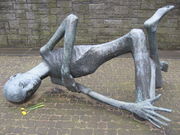
Before and during World War II, Neuengamme concentration camp, a Nazi concentration camp was established by the SS in Neuengamme—a quarter of the district Bergedorf within the City of Hamburg, Germany. The name of the concentration camp became KZ Neuengamme. Over half of its 106,000 prisoners died by the end of the war.[1] One of the few concentration camps in Germany where most of the buildings have been conserved, the site serves as a memorial to the Holocaust. It is situated 15 km southeast of the centre of Hamburg in the Vierlande area.
Contents |
Extermination through labour
The camp served the needs of the German war machine and also carried out exterminations through labour. The inmates were spread over the main camp and approximately 80 subcamps across the north German area. At least 50,000 succumbed to the subhuman conditions in the camp from hard manual work with insufficient nutrition, extremely unhygienic conditions with widespread disease, and violence from the guards.[2][3]
Work at the mother camp was centered on the production of bricks. This included the construction of a canal to transport the bricks to and from the site. Inmates had to excavate the heavy, peaty soil with inadequate tools and regardless of weather conditions or their health state.[2] From 1942, several armaments companies (e.g. Messap, Jastram, and Walther-Werke) established facilities directly next to the Neuengamme concentration camp.[4]
Victims
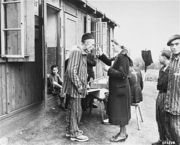
Inmates were from 28 nationalities (Soviets (34,350), Poles (16,900), Frenchmen (11,500), Germans (9,200), Dutchmen (6,950), Belgians (4,800), Danes (4,800)) and also from the local Jewish community,[2] but also included communists, homosexuals, prostitutes, Gypsies, Jehovah's Witnesses, prisoners of war and many other persecuted groups. Of 106,000 inmates, almost half died.[5][6] 20,400 victims, listed by name on the camp memorial Neuengamme, died in the camp and the subcamps. But there are actually an estimated 26,800 victims. During the last days of the camp and “evacuation” about 17,000 people died.[7] At least 42,900 victims can be verified.[8]
Inmates census
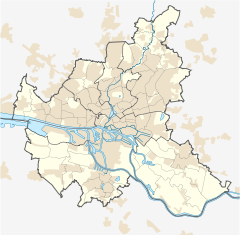
| Country | Men | Women | Overall |
| Soviet Union | 28,450 | 5,900 | 34,350 |
| Poland | 13,000 | 3,900 | 16,900 |
| France | 11,000 | 500 | 11,500 |
| Germany | 8,800 | 400 | 9,200 |
| Netherlands | 6,650 | 300 | 6,950 |
| Belgium | 4,500 | 300 | 4,800 |
| Denmark | 4,800 | - | 4,800 |
| Hungary | 1,400 | 1,200 | 2,600 |
| Norway | 2,200 | - | 2,200 |
| Yugoslavia | 1,400 | 100 | 1,500 |
| Czechoslovakia | 800 | 580 | 1,380 |
| Greece | 1,250 | - | 1,250 |
| Italy | 850 | - | 850 |
| Spain | 750 | - | 750 |
| Austria | 300 | 20 | 320 |
| Luxembourg | 50 | - | 50 |
| Other countries | 1,300 | 300 | 1,600 |
| Overall | 87,500 | 13,500 | 101,000 |
| not officially on the lists | - | - | 5,000 |
| Global overall | - | - | 106,000 |
| Dead in deportation | - | - | 55,000 |
Well known inmates
- Rein Boomsma, Dutch footballer
- Claude Bourdet, French writer and politician
- Michel Hollard, French colonel and member of the French Resistance
- Anton de Kom, Surinamese resistance fighter
- Henry Wilhelm Kristiansen, Norwegian newspaper editor and politician
- Léonel de Moustier, French politician
- Fritz Pfeffer German Jew, occupant of the Anne Frank House
- David Rousset, French writer and political activist
- Kurt Schumacher, German politician
- Johann Trollmann, German boxer
Subcamps
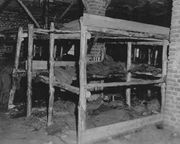
More than 80 subcamps were part of the Neuengamme concentration camp. First in 1942, inmates of Neuengamme were transported to the camp Arbeitsdorf. The dimensions of the camps differed from about 2,000 inmates to 10 or less. Several of these subcamps have memorials or at least plates, but as of 2000 at 28 locations there is nothing.[9] Dr. Garbe, from the Memorial Museum of the Neuengamme concentration camp, wrote, "The importance of the satellite camps is further highlighted by the fact that toward the ends of the war three times more prisoners were in satellite camps than in the main camp."[9]
Alderney concentration camps in Occupied British Commonwealth
The Channel Islands were the only part of the British Commonwealth occupied by Nazi Germany. The Germans built four Neuengamme subcamps on Alderney Island—the Alderney concentration camps—and named them after the Frisian Islands: Lager Norderney, Lager Borkum, Lager Sylt and Lager Helgoland. The Nazi Organisation Todt operated each subcamp and used forced labour to build bunkers, gun emplacements, air-raid shelters, and concrete fortifications. The Alderney concentration camps had a total inmate population of about 6,000.
Norderney camp housed European (usually Eastern but including Spaniard) and Russian enforced labourers. The prisoners in Lager Norderney and Lager Sylt were slave labourers forced to build the many military fortifications and installations throughout Alderney. Sylt camp held Jewish enforced labourers and was a death camp[10]. Lager Borkum was used for German technicians and volunteers from different countries of Europe. Lager Helgoland was filled with Russian Organisation Todt workers.
In 1942, Lager Norderney, containing Russian and Polish POWs, and Lager Sylt, holding Jews, were placed under the control of the SS Hauptsturmführer Max List. Over 700 of the inmates lost their lives before the camps were closed and the remaining inmates transferred to Germany in 1944.
Camp personnel
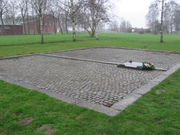
Female guards were trained at Neuengamme and assigned to one of its female subcamps. There were no SS women stationed at Neuengamme permanently. Many of these women are known by name, including Kaethe Becker, Erna Dickmann, Johanna Freund, Angelika Grass, Kommandoführerin Loni Gutzeit (who also served at Hamburg-Wandsbek and was nicknamed "The Dragon of Wandsbek" by the prisoners), Gertrud Heise, Frieda Ignatowitz, Gertrud Moeller, who also served at Boizenburg subcamp, Lotte Johanna Radtke, chief wardress Annemie von der Huelst, Inge Marga Marggot Weber. Many of the women were later dispersed to female subcamps throughout northern Germany. Today it is known that female guards staffed the subcamps of Neuengamme at Boizenburg, Braunschweig SS-Reitschule, Hamburg-Sasel, Hamburg-Wandsbek, Helmstedt-Beendorf, Langenhorn, Neugraben, Obernheide, Salzwedel, and Unterluss (Vuterluss). Only a few have been tried for war crimes, such as Anneliese Kohlmann, who served as one of only six woman guards at Neugraben.
Alfred Trzebinski (1902 – 1946) was an SS-physician, sentenced to death, and executed for his involvement in war crimes committed at the Neuengamme subcamps.
Camp Commanders
During the period as a sub-camp of the Sachsenhausen concentration camp the following SS-officers served as Lagerführer:
- SS-Sturmbannführer - Walter Eisfeld
- SS-Hauptsturmführer - Martin Gottfried Weiß, April 1940 - June 1940
As an independent concentration camp from June 1940 the following were camp commanders:
- SS-Hauptsturmführer - Martin Gottfried Weiß, June 1940 - September 1942
- SS-Obersturmbannführer - Max Pauly, September 1942 - until liberation
Timeline
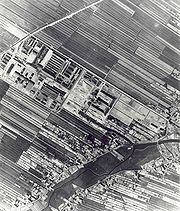
1938
In September 1938 the German Earth & Stone Works Company bought the defunct brickyard (German: Klinkerwerk) in Neuengamme. On December 13, 1938 the Neuengamme concentration camp was set up with 100 prisoners from the Sachsenhausen concentration camp.[11]
1940
In April 1940, the SS and the city of Hamburg signed a contract for the construction of a larger brick factory, and on June 4, the Neuengamme concentration camp became an independent main camp.[11]
1942
According to the testimony of Wilhelm Bahr, an ex-medical orderly, during the trial against Bruno Tesch, 200 Russian prisoners of war were gassed by prussic acid in 1942.[12] In April 1942, a crematorium was constructed at the camp, prior all bodies were taken to Hamburg for cremation.[13]
1943
In late 1943, most likely November, Neuengamme recorded its first female prisoners according to camp records.
1944
In the summer of 1944, Neuengamme received many women prisoners from Auschwitz, as well other camps in the East. All of the women were eventually shipped out to one of its twenty-four female subcamps.
In July 1944, a camp section for prominent prisoners from France was set up. End 1944 the number of prisoners were around 49,000, with 12,000 in Neuengamme and 37,000 in the subcamps.[11]
1945
On March 15, 1945, the transfer of Scandinavian prisoners from other camps to Neuengamme started. This was part of the White Buses program. On March 27, a Scandinavian camp was established at Neuengamme. On April 8, the air raid of a train with prisoners led to the Celler Hasenjagd massacre.[11]
On April 26, 1945, the Cap Arcona, loaded with about 10,000 prisoners from the Neuengamme concentration camp, Thielbek and Athen, was brought into the Bay of Lübeck. On May 3, 1945, the Cap Arcona, the Thielbek, and the passenger liner Deutschland were sunk in four separate attacks by RAF planes.
On May 2, 1945 the SS and the last prisoners left the Neuengamme camp.[11]
After the war
Following the end of the war, the camp was initially used as a Russian DP (Displaced persons) Camp, German prisoners of war were held separated. After June 1945 the camp was used by the British forces as an internment camp for SS members and Nazi officials.
Following guilty verdicts given in the Neuengamme War Trials[14], on 8th October 1946 British executioner Albert Pierrepoint hanged the following 11 people at Hamelin Prison for war crimes perpetrated at Neuengamme concentration camp during the war:
- Max Pauly
- SS Dr Bruno Kitt
- Anton Thumann
- Johann Reese
- Willy Warnke
- SS Dr Alfred Trzebinski
- Heinrich Ruge
- Wilhem Bahr
- Andreas Brems
- Wilhelm Dreimann
- Adolf Speck
Others convicted of crimes committed at Neuengamme received varying terms of imprisonment.
The Civil Internment Camp No. 6 was closed on 13 August 1948. Since 1948 the city of Hamburg used the camp as a prison. Several original buildings of the camp continued to serve as locations in this prison (for example Building Number 9), until February 2006. Since the demolition of the new-build structures in 2007 the whole area is used as a memorial.[15]
Memorial
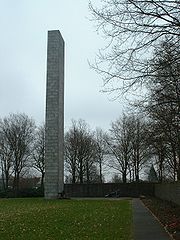
The KZ-Gedenkstätte Neuengamme (Neuengamme memorial site) is located at Jean-Dolidier-Weg 75 in Bergedorf. A first memorial was erected in 1953 on the site of the former camp garden. It was expanded in 1965, and a "document house" was added in 1981. In 1989, the Hamburg Senate decided that the prisons erected in 1950 and 1970 on the camp site should be relocated. The older one was closed in 2003, the newer in 2006. In 2005 a new memorial site and museum were opened. Since 1985, there are also memorials at the subcamps Fuhlsbüttel and Sasel, and in the Bullenhuser Damm school, where a number of children were murdered after being subjected to medical experiments.[16]
Three of the camp's outposts also serve as public memorials. These are located at Bullenhuser Damm, Kritenbarg 8 and Suhrenkamp 98.
The first of these is a memorial to the murder of 20 children from the Auschwitz concentration camp who had been taken to Hamburg and abused for medical experiments. On April 20, 1945, only weeks before the war was over, they were killed to cover up that crime. The second is an outpost of Neuengamme concentration camp in Hamburg-Sasel where Jewish women from the Łódź Ghetto in Poland were forced to do construction work. The third one is located inside the gatehouse of the Fuhlsbüttel penitentiary. Parts of this complex served as concentration camp for communists, opponents of the regime and many other groups. About 450 inmates were murdered here during the Nazi reign.
Ongoing historical research
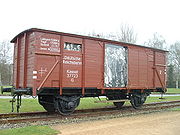
Due to the demolition of the Neuengamme camp and its records by the SS in 1945 and the transportation of inmates to other subcamps or other working locations, the historical work is difficult and ongoing.[17] For example: in 1967 the German Federal Ministry of Justice stated the camp from September 1, 1938 until May 5, 1945.[18] In 2008, the organisation of the Neuengamme memorial site (German: KZ-Gedenkstätte Neuengamme)—an establishment of the Hamburg Ministry of Culture, Sports and Media—stated that the empty camp was explored by British forces on May 2, 1945 and the last inmates were liberated in Flensburg on May 10, 1945.[11] The United States Holocaust Memorial Museum stated that the camp was established on December 13, 1938 and liberated on May 4, 1945.[13]
See also
- List of Nazi-German concentration camps
- SS Cap Arcona
- Celler Hasenjagd (Massacre in Celle after an air raid)
Notes
- ↑ Staff (1967-02-23), Verzeichnis der Konzentrationslager und ihrer Außenkommandos gemäß § 42 Abs. 2 BEG, Bundesministerium der Justiz, http://bundesrecht.juris.de/begdv_6/anlage_6.html, retrieved 2008-10-12, "11034 Neuengamme, 1.9.1938 bis 5.5.1945 bis 3.6.1940 Sachsenhausen" (German)
- ↑ 2.0 2.1 2.2 "Neuengamme". USHMM. http://www.ushmm.org/wlc/article.php?ModuleId=10005539. Retrieved 2009-08-18.
- ↑ "History". KZ Gedenkstätte Neuengamme. http://www.kz-gedenkstaette-neuengamme.de/index.php?id=941. Retrieved 2009-08-18.
- ↑ "Areas of work". KZ Gedenkstätte Neuengamme. http://www.kz-gedenkstaette-neuengamme.de/?id=993. Retrieved 2009-08-18.
- ↑ "Konzentrationslager Neuengamme". KZ-Gedenkstätte Neuengamme. http://www.kz-gedenkstaette-neuengamme.de/index.php?id=12. Retrieved 2008-10-12. "Insgesamt wurden im KZ Neuengamme nach gegenwärtigen Erkenntnissen über 80 000 Männer und mehr als 13 000 Frauen mit einer Häftlingsnummer registriert; weitere 5 900 Menschen wurden in den Lagerbüchern gar nicht oder gesondert erfasst.[…]Vermutlich mehr als die Hälfte der 100400 Häftlinge des Konzentrationslagers Neuengamme haben die nationalsozialistische Verfolgung nicht überlebt." (German)
- ↑ "Neuengamme". USHMM. http://www.ushmm.org/wlc/article.php?lang=en&ModuleId=10005539. Retrieved 2008-10-12. "In all, more than 50,000 prisoners, almost half of those imprisoned in the camp during its existence, died in Neuengamme before liberation."
- ↑ Günther Schwarberg: Angriffsziel „Cap Arcona“. Überarb. Neuauflage, Göttingen 1998.“ (German)
- ↑ www.kz-gedenkstaette-neuengamme.de: Death, KZ Gedenkstätte Neuengamme, http://www.kz-gedenkstaette-neuengamme.de/index.php?id=990, retrieved 2009-08-19
- ↑ 9.0 9.1 Höhler, Hans-Joachim (2000), Gedenkstätten für die Opfer des KZ Neuengamme und seiner Außenlager, Neuengamme: Arbeitsgemeinschaft Neuengamme and KZ-Gedenkstätte Neuengamme (German) (English) (French) (Russian)
- ↑ Subterranea Britannica (February 2003), SiteName: Lager Sylt Concentration Camp, http://www.subbrit.org.uk/sb-sites/sites/a/alderney/lager_sylt/index.shtml, retrieved 2009-06-06
- ↑ 11.0 11.1 11.2 11.3 11.4 11.5 KZ-Gedenkstätte Neuengamme: Timeline, Memorial Neuengamme, http://www.kz-gedenkstaette-neuengamme.de/index.php?id=998, retrieved 2009-08-18
- ↑ "The Zyklon B Case: Trial of Bruno Tesch and Two Others". United Nations War Crimes Commission. 1947. http://www.ess.uwe.ac.uk/WCC/zyklonb.htm#Dr.%20Tesch.
- ↑ 13.0 13.1 "Neuengamme 1938 - 1945 Timeline". USHMM. http://www.ushmm.org/wlc/media_cm.php?lang=en&ModuleId=10005539&MediaId=2538. Retrieved 2008-10-12.
- ↑ http://www.axishistory.com/index.php?id=360
- ↑ KZ-Gedenkstätte Neuengamme: Timeline, Memorial Neuengamme, http://www.kz-gedenkstaette-neuengamme.de/index.php?id=1004, retrieved 2009-03-08
- ↑ Website concentration camp memorial (German)
- ↑ Staff, Etappen der Lagerräumung, KZ-Gedenkstätte Neuengamme, http://web.archive.org/web/20070928223659/http://staging3.hauptsache.net/?id=550, retrieved 2008-09-26 (German)
- ↑ Staff (1967-02-23), Verzeichnis der Konzentrationslager und ihrer Außenkommandos gemäß § 42 Abs. 2 BEG, Bundesministerium der Justiz, http://bundesrecht.juris.de/begdv_6/anlage_6.html, retrieved 2008-09-26 (German)
External links
- Official website of the memorial Neuengamme (German)
- jewishgen.org Neuengamme page
- ushmm.org Neuengamme page
- Stichting Vriendenkring Neuengamme (Dutch)
- Axis History Factbook: SS personnel serving at Neuengamme.
|
||||||||||||||||||||||||||